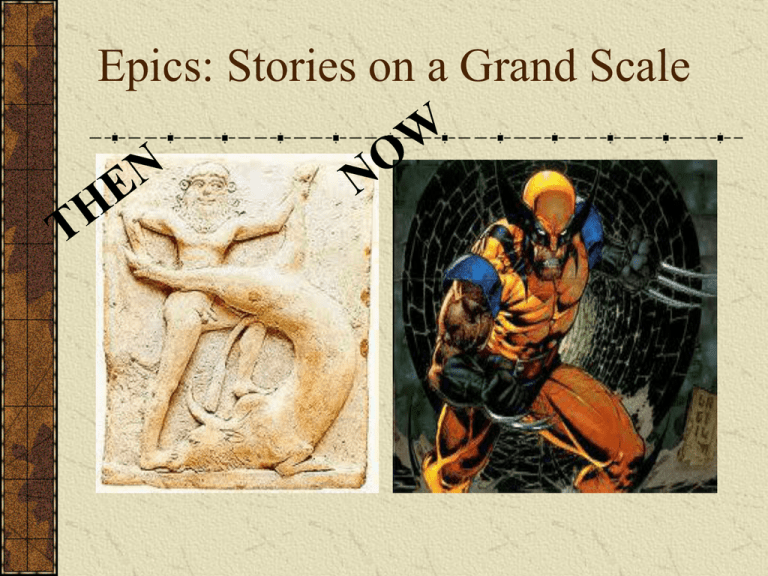THEN NOW Archetypes: Always look for
advertisement

Epics: Stories on a Grand Scale Epics: Stories on a Grand Scale Epics: Stories on a Grand Scale Archetypes: Always look for GOOD VS EVIL Stories may have some dark side of the hero. (SINS) Annekin changes to Darth Vader: a fallen Jedi who uses the “dark side” of the Force Gollum: a hobbit corrupted by the One Ring Characteristics of an epic: The hero, generally male, is of noble birth or high position, related to GODS The hero’s character traits reflect important ideals of his society The hero performs courageous deeds that reflect the values of the times His actions determine the fate of many Characteristics of an epic continued: The setting is vast Written in formal diction with a serious tone Characters have long, formal speeches Hero’s journey (slides to follow) Poem reflects timeless values (courage, etc) Treats universal themes (good vs. evil, etc.) The hero takes a journey to foreign lands. 3 phases of the hero journey: •Separation – a break away from local social order, the beginning of a quest. •Initiation – a long deep retreat inward with a series of chaotic encounters which provide new insight. •Return – reintegration into society, coming back as as a more evolved person. The general points of the cycle include: •a test (to test worthiness to complete said quest) •a main antagonist, often supernatural •a magical/unreal world, unable to be visited by a normal human, that the hero visits (e.g. the underworld or the world of the gods) •a resurrection (either from being dead or from a dead-like state of mind, or a hero who was thought to be dead who was rediscovered) Identify a hero or heroine from a film or story and explain how their journey fits the three phases – be sure to give examples. Themes & Look for the struggles of … Conflict •good against evil •strength against weakness •light against dark Read through the descriptions of the hero and villain archetypes. 1. Decide on five of the archetypes that fit your personality best and draw and label a pie chart representing these archetypes proportionately. 2. Write in paragraph format about how the three most dominant archetypes show up in your personality. Be specific by giving multiple examples. Contrast Characters Foil - a character whose personality or attitudes are in sharp contrast to those of another character in the same work. The foil character helps to define the other character through strong contrast. Fresh Prince of Bel Air Will Carlton Looney Tunes Elmer Fudd Buggs Bunny Spongebob Squarepants Spongebob Squidward Harry Potter Draco Malfoy Harry Potter Romeo and Juliet Romeo Mercutio Can you think of any characters that contrast each other? Gilgamesh: Foil Characters Enkidu Gilgamesh Humbaba Huwawa [Humbaba], the Mesopotamian Forest God, protected forests. The antagonists of this EPIC story EPICS and Mythological Analysis • Archetypes comes from the Greek word archetypos, meaning “first of its kind.” • They are universal images/concepts/ ideas that come from shared common experiences, which transcend time, place and culture. • The value in using archetypal characters in fiction derives from the fact that we unconsciously already recognize the archetype, and thus the motivations, behind the character's behavior. examples EPIC POEMS QUIZ 1. What are the 3 phases of the hero ‘s journey 2. What is the main purpose of the FOIL? 3. Who is the antagonist of a story? 4. What kind of language is an EPIC poem written in? 5. In your own words describe an ARCHETYPE. BONUS: Create a list of ARCHETYPES that show up in EPIC poems.


